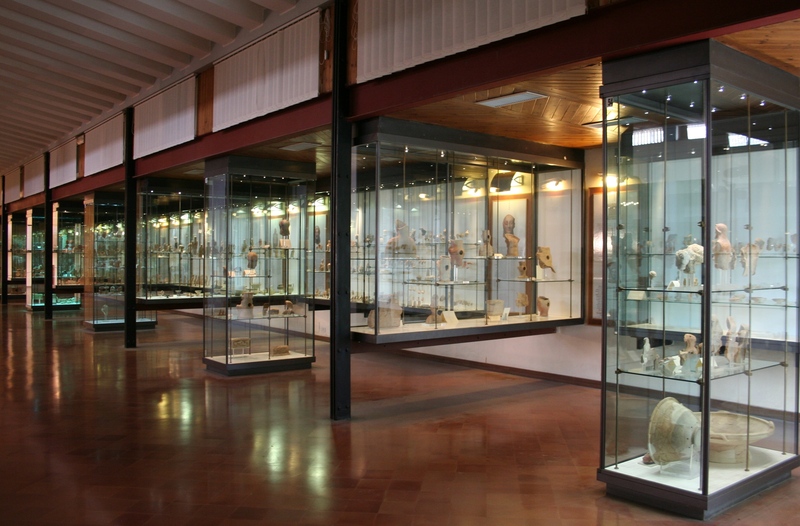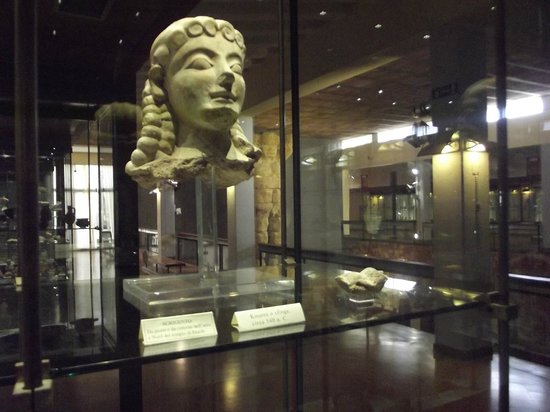The place
The exhibition in this room is entirely devoted to sanctuaries and is arranged around the large space of Room VI, dedicated to the temple of Olympian Zeus.
The south gallery contains display cases with materials from the sanctuaries of the chthonic deities, to whom Akragas was particularly devoted, so much so that Pindar, in his 12th Pythian Ode, refers to it as “the home of Persephone.” These sanctuaries were located in different areas: one at the western end of the hill of temples, another in the locality of Sant'Anna beyond the walls, and others on the slopes of the Rupe Atenea, in the locality of San Biagio and beyond the ancient walls.
The temple architecture of Akrágas is characterized by its monumental nature and the use of advanced technical solutions. The temple of Olympian Zeus is one of the most imposing and representative of the ancient city, with a powerful structure and innovative external decoration featuring telamons, colossal male figures in stone supporting the architrave, alternating with half-columns with Doric capitals.
Sacred buildings dedicated to chthonic deities were often characterized by the presence in the surrounding area (temenos) of bothroi, pits for votive offerings, and monumental altars, as in the sanctuary in the western part of the hill of temples or in that of Demeter near San Biagio, while in the locality of Sant'Anna there were probably structures connected with chthonic worship. Fragments of architectural decorations bear witness to the decorative richness of the temples. The use of polychromy in the decorative elements highlights the importance of color in Greek sacred architecture, while the use of local limestone structures, plastered and painted, reveals the ability of ancient architects to adapt available resources to the aesthetic and functional requirements of sacred buildings.
The myth linked to the chthonic deities is certainly one of the most fascinating of ancient Greek mythology, deeply connected to the cycle of the seasons and the abundance of the earth's produce with which to feed oneself and enrich one's diet, but also to the idea of the immortality of the soul and the afterlife. The myth tells that Persephone, daughter of Demeter, was kidnapped by Hades, the god of the underworld. Demeter, desperate, searched in vain for her daughter and, despite being the goddess of the earth, in her despair she no longer cared for nature and the harvests. Zeus, unable to allow this to continue, with the risk of leading humanity to famine and death, sent Hermes to Hades to persuade him to release Persephone. Hades obeyed but, before letting her go, he made his bride eat six pomegranate seeds, which would force her to return to him for six months of the year, in the realm of the underworld. When Persephone returned to earth, nature, inspired by Demeter's newfound happiness, reawakened, and plants blossomed again, growing lush and rich with fruit. The alternation of Persephone's dwelling on earth and in the underworld reveals the alternation of seasons in the Mediterranean world, with spring and summer rich in harvests, and autumn and winter bare and fruitless. Symbolically, the myth of the two female deities exalts nature's ability to awaken each year from its winter slumber, and thus the possibility of returning to life after death, but also the value of marriage and fertile reproduction. This is why the cult was mainly followed by women (Demeter was also the goddess of fertility), and most of the archaeological finds are related to the female world. Most of them come from the rich votive deposit found in the area west of the temple hill, where an archaic sanctuary with sacelli, altars, and bothroi was monumentalized over time with the construction of two temples, one of which is still visible today in the anastylosis of the northwestern corner, known as the temple of the Dioscuri.
The display cases contain a large number of clay votive masks of female deities with holes in the headdress area, probably for the insertion of diadems or crowns made of precious metals (vv. 42-43), statuettes of seated or standing deities with flattened bodies, sometimes wearing polos on their heads and various types of necklaces on their chests, together with those of female worshippers bearing gifts of torches, piglets, doves, drinking vessels, and pater. A very unusual find is the ritual clay tube with an aniconic representation of a deity, suggested only by the presence of ears and hair styled to frame the forehead, on which there is a polos; the object, inserted into the ground, was probably used to communicate ideally with the underworld.
Of particular interest in display cases 47 and 48 is the exhibition of clay molds of various shapes, alongside their recent reproductions: these are evidence of mass production that must have taken place in local pottery workshops, some of which have been identified near the fifth gate of the Greek city walls, in the immediate vicinity of the sanctuary in question; among them are those depicting Medusa and Heracles with the Erymanthian boar in the presence of Eurystheus, who can be glimpsed, frightened, inside a pithos (see 47).
Other finds of considerable interest are two female clay heads, one of a girl with overlapping waves of hair, and another with a helmet, on which the marks of the colors used to decorate the sculpture can still be seen, another important detail for imagining the polychromy used in antiquity. Showcases 49 and 52 display a wide variety of votive objects: in addition to the female statuettes, which repeat what we have already seen, there are many with male representations, animals, especially birds, but also turtles, lions, and cattle, fragments of black- and red-figure vases, loom weights, oil lamps, fragments of architectural terracotta, and bronze objects: umbilical votive paters and miniature reproductions of musical instruments, such as tympana, used during sacred processions in honor of the gods.
Showcases 53 and 55 are reserved for the rock sanctuary near San Biagio: on display are unusual artifacts consisting of shapeless busts that contrast with finely modeled female heads, sometimes with hairstyles crowned by elaborate headdresses, as well as a fragment of an arula with a scene of animals fighting and vases of various sizes, among which the miniature forms and kernoi stand out, a sort of multi-spouted oil lamp typical of the cult of the chthonic deities and used especially during nighttime rituals.
The two front display cases contain materials from various sacred areas, typical of Akragas craftsmanship.
In display case 56, in addition to fragments of arule and terracotta decorations reproducing the caryatid or telamon motif, there are numerous fragments of louteria rims, large basins for ritual ablutions supported by various types of supports made of different materials and decorated in relief with motifs obtained by rolling a roller over the still-fresh clay, thus always producing the same repeated scene. Many feature racing quadrigas and Nikai separated by Doric columns, while the most characteristic one features a motif of dancing comasti around a large vase, posed in a variety of positions.
The same display case also contains materials from the suburban sanctuary of Sant'Anna; in the lower part, you can see a large terracotta statue base and a locally made pithos which, at the time of its discovery, was full of pieces of aes rude and various bronzes, constituting a veritable treasure trove in the pre-monetary era. Display cases 57 and 59 contain numerous fragments of architectural terracotta (which formed the entablature and tiled roofs of temples and buildings of various purposes), mainly from the sanctuaries of Hephaestus and Heracles. Their polychromy and variety of iconographic motifs testify to the decorative exuberance of ancient sacred buildings.
The north gallery displays materials from other Akragantine sanctuaries in its display cases. Particularly significant are the artifacts found in some wells north of the temple of Heracles (vv. 58-60), including a kouros head and a beautiful arula depicting the fight between Heracles and Ares, with the body of Cycnus at their feet, as well as an evocative and plastically perfect male head (photo above) and two statuettes of Artemis from the Hellenistic period (v. 60).
From the sanctuary of Zeus, a large antefix with Gorgon (v. 61) and a series of plastic balsamari with female faces, while from the sacred area of the hill of San Nicola, on which the entire museum structure stands, there are fragments of painted roof tiles and black-figure and red-figure vases of Magna Graecian production (see 64), as well as several fragments of marble sculptures and other objects bearing inscriptions in Greek and Latin (see 65).




